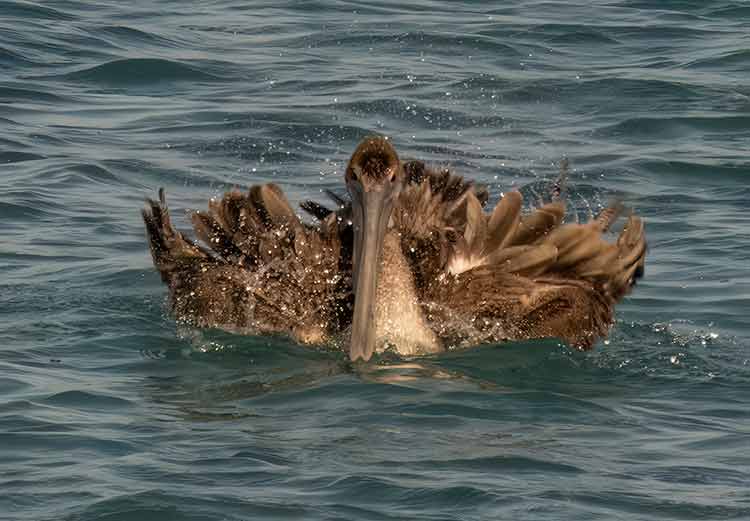Avian Thermoregulation
How birds keep their cools in Bonaire’s heat.
Posted September 22, 2022
How do birds keep cool when ambient temperatures soar in hot weather? Why, by avian thermoregulation!
The heat index seems to climb with each passing day here on Bonaire, as we’re in September, generally our hottest month of the year. It’s not only sweltering for us humans, but also for many of our feathered friends.
Wild birds also find the high ambient temperatures difficult, and thus they need to find ways to reduce their internal temperatures or body heat. Birds have adapted a number of ways that allow them to get rid of excess heat by regulating their body temperature using avian thermoregulation. This means that they control the amount of heat produced by their bodies and they can dissipate excess heat through various mechanisms.
Birds, along with mammals, are endothermic.
As opposed to ectothermic (cold-blooded) organisms, such as lizards (which must use the sun to warm their bodies), birds and mammals are endothermic, so they can produce heat to keep their internal temperature at a constant level. In general terms, metabolic heat production provides the capacity for maintaining a core body temperature that is different from the ambient temperature and allows for avian thermoregulation.
Maintaining this core body temperature at a stable level, no matter the ambient temperature, means that birds must expend a great portion of their total energy to keep the status quo. In cooler climates, they need to generate heat. In warmer climates, such as they are now experiencing on Bonaire, they need to get rid of excess heat.
When it comes to avian thermoregulation, birds have developed some unique adaptations to cope with high temperatures. For example, they can reduce their heart rates, lower their respiratory rates, and even change their feathers’ color to reflect sunlight. These adaptations allow them to save energy and remain comfortable in hot environments.
Let’s take a closer look at a few of the mechanisms that you might observe Bonaire’s birds utilizing right now in order to keep their cool!
Gular Fluttering (or panting):
Gular fluttering is a behavior of opening the bill and then vibrating the thin gular membranes of the throat so that heat is dissipated via evaporative cooling. Since birds do not have sweat glands, this type of panting is especially effective as it increases airflow across moist surfaces, and thus dissipates heat.
In this video of a Great Blue Heron (Ardea herodias), you can easily see this movement. Although the gular fluttering movement itself expends some of the bird’s energy, the benefits of the evaporative cooling far outweigh the extra energy expenditure.
Air Circulation:
In some cases, you might see smaller birds repeatedly open and close their wings while standing in one location. Or, like this Yellow-crowned Night Heron (Nyctanassa violacea), larger birds might stand and allow their wings to open and droop. Both of these maneuvers create better air circulation around the body, sweeping away excess heat.
Enjoying a cooling bath:
You might see birds along the shoreline taking more baths these days, as they also can cool down by submerging exposed skin, which dissipates body heat into the cooler water surrounding them–the same as we humans enjoy a nice swim on a hot day. Some birds will even fluff up their feathers afterward and open their wings to catch the breeze while drying off, cooling them even more.
How to help birds keep their cool!
Provide water for bathing and drinking.
If you’re here on Bonaire in the coming months, help the garden birds by providing extra water for them. Adding in a solar fountain provides birds with water to bathe (and also to drink) while keeping them safe from predators.
Provide some shade.
Try to place the bird bath in a shady area to help our feathered friends find relief from the intense tropical sun.
In summary, birds have evolved many ways to stay cool in the tropics.
As you are birding in the coming weeks, keep your eyes open for these fascinating behaviors that different birds will employ to keep their cool.
If you’re able, help them out with shade and water. Our feathered friends will thank you!
Sign up to receive notifications when a new article is posted.
About the author:
 Susan has been living on Bonaire for over 30 years. She is a certified bird guide, as well as a topside and underwater photographer. She is a 2016 graduate of the Caribbean Birding Trail Interpretive Guide Course conducted by BirdsCaribbean.
Susan has been living on Bonaire for over 30 years. She is a certified bird guide, as well as a topside and underwater photographer. She is a 2016 graduate of the Caribbean Birding Trail Interpretive Guide Course conducted by BirdsCaribbean.
Get in touch with Susan
Contact Susan via email, Facebook Messenger, call Susan or use the online form below.
If you have any questions about your Bonaire birding tour, feel free to contact Susan for answers. She is always willing to go into more detail about routes or the best times for a tour based on your personal preferences. Tours can be tailored to your interests, whether that be birds, photography, or both!
It is also a good idea to do some homework on the birds of Bonaire before you come. Knowing a little about the birds you might encounter on your tour will make your experience even more enjoyable!
Be sure to check out these resources for birding on Bonaire. Also, reading the Bird Blog will introduce you to the birds that might be observed on Bonaire.
Get In Touch
Get in touch with Susan to check availability for the dates you are visiting Bonaire.
Consent: By using this form you agree with the storage and handling of your data by this website.







